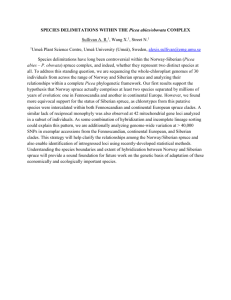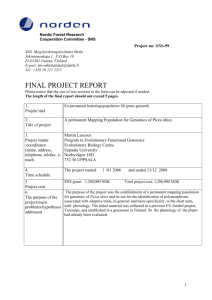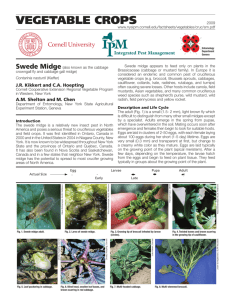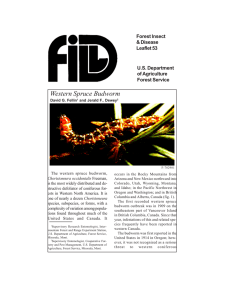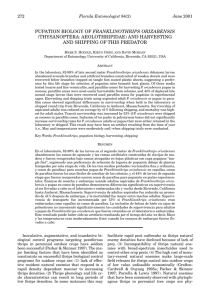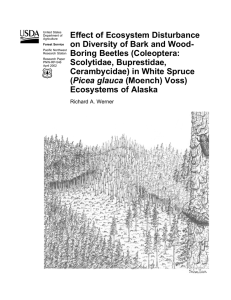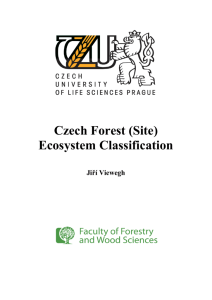Resseliella ingrica
advertisement
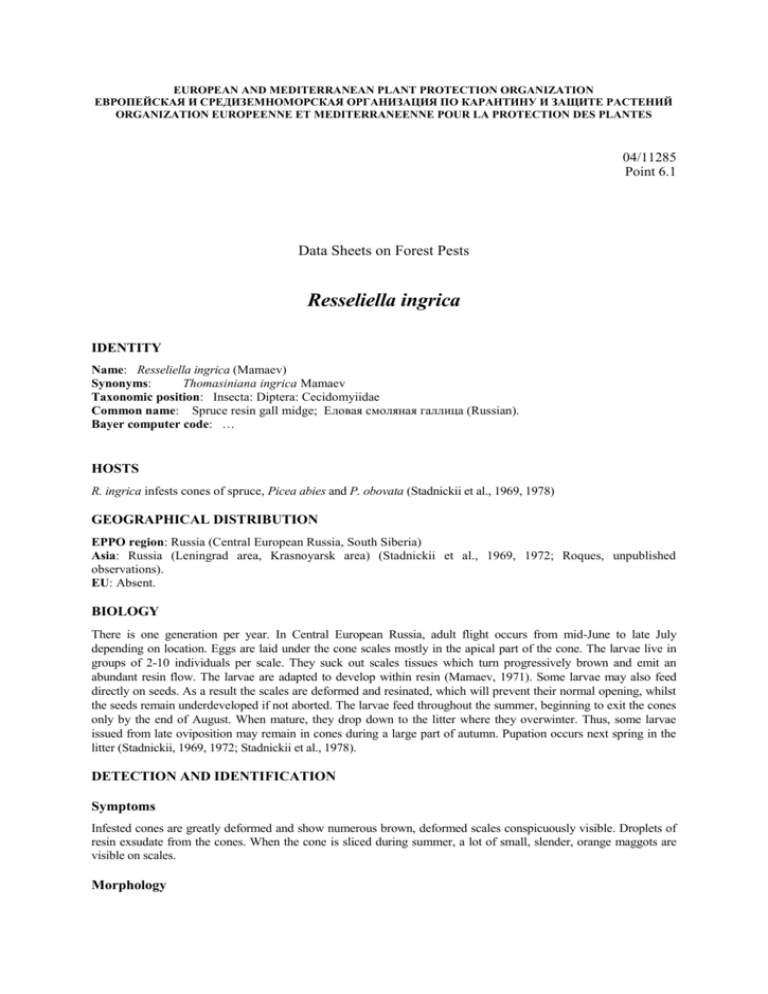
EUROPEAN AND MEDITERRANEAN PLANT PROTECTION ORGANIZATION ЕВРОПЕЙСКАЯ И СРЕДИЗЕМНОМОРСКАЯ ОРГАНИЗАЦИЯ ПО КАРАНТИНУ И ЗАЩИТЕ РАСТЕНИЙ ORGANIZATION EUROPEENNE ET MEDITERRANEENNE POUR LA PROTECTION DES PLANTES 04/11285 Point 6.1 Data Sheets on Forest Pests Resseliella ingrica IDENTITY Name: Resseliella ingrica (Mamaev) Synonyms: Thomasiniana ingrica Mamaev Taxonomic position: Insecta: Diptera: Cecidomyiidae Common name: Spruce resin gall midge; Eлoвaя cмоляная галлица (Russian). Bayer computer code: … HOSTS R. ingrica infests cones of spruce, Picea abies and P. obovata (Stadnickii et al., 1969, 1978) GEOGRAPHICAL DISTRIBUTION EPPO region: Russia (Central European Russia, South Siberia) Asia: Russia (Leningrad area, Krasnoyarsk area) (Stadnickii et al., 1969, 1972; Roques, unpublished observations). EU: Absent. BIOLOGY There is one generation per year. In Central European Russia, adult flight occurs from mid-June to late July depending on location. Eggs are laid under the cone scales mostly in the apical part of the cone. The larvae live in groups of 2-10 individuals per scale. They suck out scales tissues which turn progressively brown and emit an abundant resin flow. The larvae are adapted to develop within resin (Mamaev, 1971). Some larvae may also feed directly on seeds. As a result the scales are deformed and resinated, which will prevent their normal opening, whilst the seeds remain underdeveloped if not aborted. The larvae feed throughout the summer, beginning to exit the cones only by the end of August. When mature, they drop down to the litter where they overwinter. Thus, some larvae issued from late oviposition may remain in cones during a large part of autumn. Pupation occurs next spring in the litter (Stadnickii, 1969, 1972; Stadnickii et al., 1978). DETECTION AND IDENTIFICATION Symptoms Infested cones are greatly deformed and show numerous brown, deformed scales conspicuously visible. Droplets of resin exsudate from the cones. When the cone is sliced during summer, a lot of small, slender, orange maggots are visible on scales. Morphology 2 Eggs No description available Larva The larvae present a flattened body, with a pair of spiracles on each segment except 2 nd and 3rd segments from the front (Fig. 1). A typical dark bilobed sternal spatula is present on the anterior-ventral part of the body. The hind extremity shows 2 prominent, pointed lobes. There are 3 larval instars. The neonate larva is yellowish. Then, the 2nd and 3rd instars progressively turn to clear orange orange- rose or orange- red. The mature larva is 3.5 mm long (Stadnickii et al., 1978). Fig. 1. Mature 3rd- instar larva of Resseliella ingrica (Roques, unpublished), showing enlarged sternal spatula on left side. Scale bar for body: 1 mm. Pupa The pupa is of reddish colour, and about 3 mm long, (Stadnickii et al., 1978). Adult The adult of R. ingrica is a fragile, minute midge with translucent wings and thin, elongate antennae and legs. Body colour is mostly grey with some yellowish parts. The length of the body is 4.0 mm (Stadnickii et al., 1978). MEANS OF MOVEMENT AND DISPERSAL Adults of R. ingrica are poor flyers. An early cone collection before the larval drop-down is achieved may cause contamination of consignments of seeds by mature midge larvae which are capable of pupating within the seed lots. This is favouring the dispersal of this insect over long distances as it has been suggested for a related species, R. piceae (Roques et al., 2003). PEST SIGNIFICANCE Economic Impact Direct damage to seeds is usually low but the presence of 10-15 larvae in a cone is susceptible to result in large resin flows which prevent the infested cone to shed most of its sound seeds (Stadnickii et al., 1978). The resulting decrease in seed crop is more important for seed orchards than for natural stands in the European part of Russia (Stadnickii, 1969, 1972). Environmental Impact R. ingrica may affect locally the potential of natural regeneration of Picea abies and P. obovata. Control No control methods yet tested. A Ceraphronoidea species, probably Aphanogmus thomasiniane Alekseev and Dolgin, is known as a natural enemy. 3 Phytosanitary risk R. ingrica is already attacking a spruce species, Picea abies, largely used for afforestation in many EPPO countries, especially of Northern and Central Europe. Thus, it will probably have no problem to establish in these countries. Moreover, Resseliella spp. are oligophagous species capable of surviving on new hosts that are congeneric with the original one (Roques et al., 2003), and R. ingrica is likely to shift onto most of the other native and exotic spruce species growing in EPPO countries. PHYTOSANITARY MEASURES To prevent introduction of C. pumila to other countries, the effective measure would be clean the spruce seed lots to be imported, systematically removing midge larvae when they occur. BIBLIOGRAPHY Mamaev B.M. (1971)[Use of conifer resin as an habitat for insects] (in Russian). Zh. Obshch. Biol. 32: 501- 507. Stadnickii G.V. (1969). Die entomofauna der Fichtenzapfen (Picea abies L. Karst.) des europaïschen teiles der USSR. Anz. Schädlingskd. Pflantzen Umweltsh. 10: 145-150. Stadnickii G.V. (1971). Characteristics of cones of Norway spruce as an habitat and the complex of insects infesting them. Entomol. Rev. 50: 50-55. Stadnickii G.V., Iurchenko G.I., Smetanin A. N., Grebenshchikova V.P., Pribylova M. V. (1978). Coniferous cone and seed pests. Lesnaia Promyshlennost, Moscow. 168 pp. [in Russian].

